About two thousand species of catfish are known, which in nature inhabit fresh waters of all continents (with the exception of Antarctica). An important feature of this group is the absence of scales, which are replaced by bone plates. Catfish have adapted to life in a wide variety of conditions, they are quite unpretentious, hardy, able to defend themselves against the attack of even larger fish, while many of the species themselves are peaceful, which makes them excellent candidates for settling in a common aquarium.
Ancistrus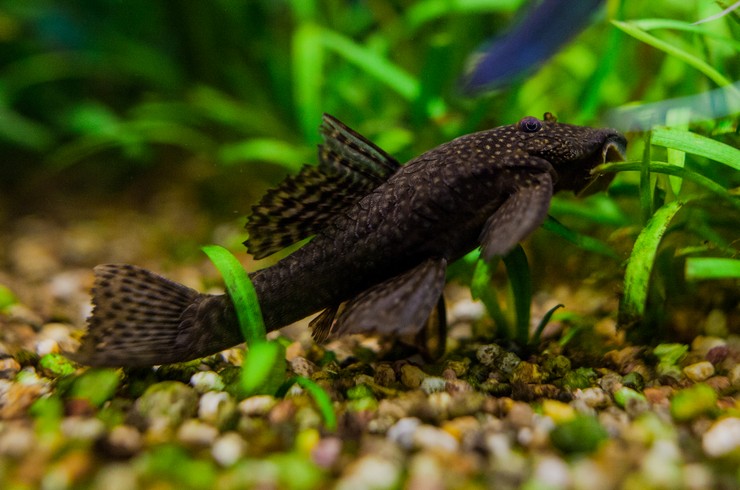
Among the aquarium catfish, perhaps the most famous is the ancistrus or sticky catfish. These aquatic inhabitants belong to the chain-mail catfish family, which are often found in aquariums by both novice and experienced aquarists. The size of fish usually does not exceed 15 cm, while they bring invaluable benefits, eating algal fouling from plant leaves, decorations, and glass of the aquarium. These indefatigable laborers do an excellent job of cleaning up the job.
Among the morphological features, one can distinguish a flattened body covered with bony plates, and a developed oral suction cup with tubercles intended for scraping algae. The main decoration of pubertal males of ancistrus is numerous outgrowths on the head – tentacles.
Ancistrus are well suited for keeping in a common aquarium, to whose other inhabitants they rarely pay attention to. Catfish are active at dusk, spending most of the time at their favorite pastime – sucking on glass and decorations, scraping algal growths off them.
In an aquarium with ancistrus, natural driftwood must be present, which is a source of the cellulose necessary for the catfish to function properly.
The basis of the diet of ancestors catfish is plant food, it is recommended to feed them with high-quality dry food in the form of sinking tablets, which will allow the fish to easily find them at the bottom.
Corridor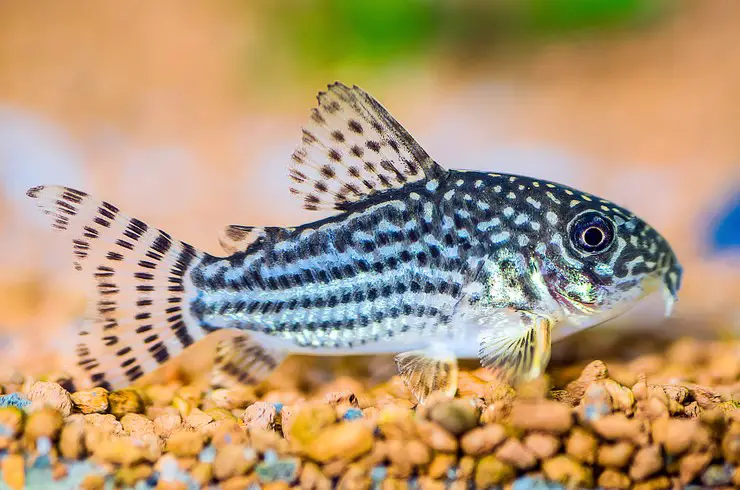
Corridors are widely known among aquarists as restless workers constantly scurrying around the bottom in search of food. These small fish range in size from 3 to 12 cm, are peaceful, and are considered some of the hardiest, making them an excellent choice for beginner hobbyists.
The body of the corridors is short, the abdomen is flattened, the back is convex. The color of different representatives of the genus is different, characterized by olive and golden shades with a metallic sheen and dark spots, in some species with stripes running along the body. Albino forms are available.
Catfish have the ability to swallow atmospheric air using the so-called intestinal respiration.
Corridors are settled in an aquarium with a volume of 60 liters or more in small flocks. It is worth paying attention to the soil – sharp edges can damage the sensitive antennae of the fish, with which they rummage the bottom in search of food, therefore it is recommended to use rounded pebbles or sandy soil. In aquariums with these catfish, it is necessary to ensure good filtration and aeration.
In food, the fish are picky, they eat any food particles that fall to the bottom. It is advisable to put sinking tablets for catfish on the basis of the diet, which fully satisfies their nutritional needs.
Loricaria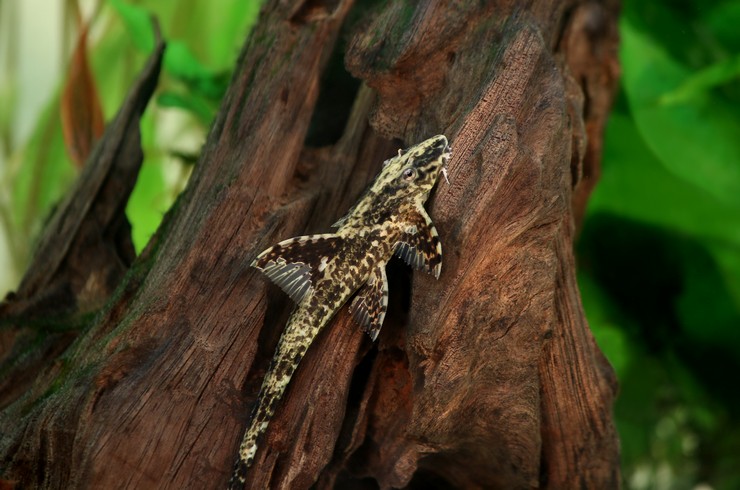
Loricaria, or catfish-whip, is an extremely interesting representative of the Kolchuga catfish family. Despite the fact that these catfish have not yet received sufficient distribution, their unusual appearance, ability to exist in a wide range of conditions of keeping, and coexistence with other aquatic inhabitants make them very promising for keeping in hobbyist aquariums.
The thin, strongly elongated body of the Loricarius (up to 12 cm in size) attracts attention, for which the catfish-lash got its second name.
To keep loricaria, depending on the type and number of individuals, you will need a container with a volume of 40 to 150 liters. You can put one individual, a couple, or a group of fish in the aquarium.
It is easy for these catfish to pick up neighbors because they are extremely peaceful, often hide, and prefer not to enter into conflicts with other species. Therefore, you should not settle with them roommates who can offend them – overly active, fans of biting fins.
Loricaria is also very beneficial by eating up leftover food that has been missed by other inhabitants of the aquarium, this helps to keep it clean.
Otozinklus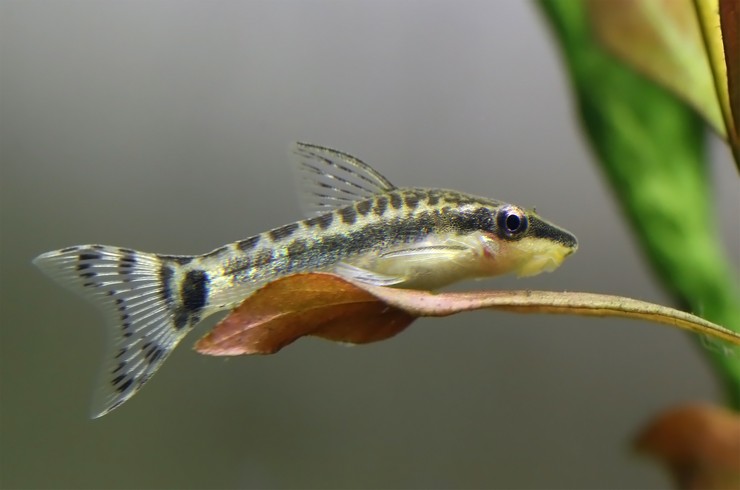
Otocyclus is the smallest representative of the Lorikarev catfish. The size of these babies rarely exceeds 3 centimeters, however, their diminutiveness is completely compensated for by the incommensurate hard work and diligence of catfish in the fight against the main misfortune of aquarists – algae. But ototsinkluses will not only free your aquarium from the lower plants that have already appeared, but they will also do it so delicately that you can not worry about even the most delicate plants. It is not for nothing that these fish have earned the love of the famous master of aquascaping – Takashi Amano, who used ototsinkluses just as often as freshwater shrimps named after him.
Catfish attract attention not only by the benefits they bring but also by their rather interesting color. There are species with a variety of spots, a golden tint, and even a “zebra” color – alternating black and white stripes.
Otozinklus are perfect for keeping in popular nano-aquariums because 40 liters of water will be enough for a small school of these fish. Otozinklus are peace-loving catfish that cannot offend anyone, however, overly large or active fish can attack them, so it is better to approach the issue of choosing neighbors more carefully.
Pangasius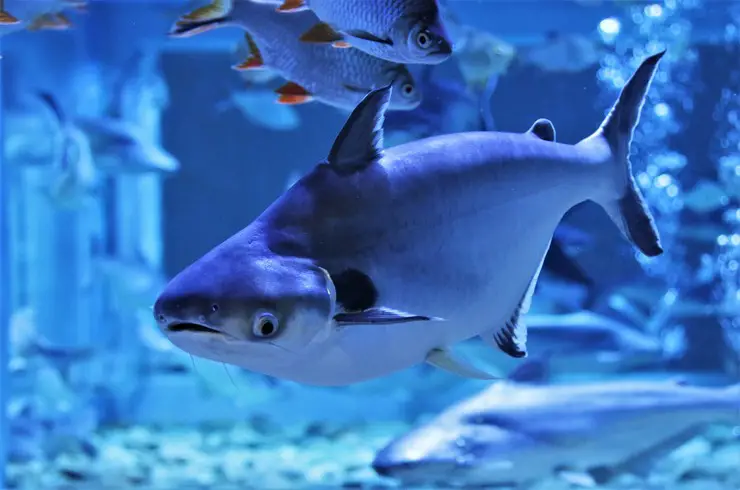
Among freshwater catfish, pangasius, especially high fin, most closely resemble real sea sharks. And the size of these fish matches, because in sufficient volume they can easily grow up to a meter in length. Pangasius is best suited for decorating large pseudo-more-style aquariums. Corals, pebbles, a sunken treasure chest, and a shark guarding them are not a piece of the real seabed.
The most important thing is not to forget that such large inhabitants definitely need space for swimming, which means that you need to think about an aquarium of 1000 liters or more. Despite their formidable appearance, pangasius is very shy. Even simple cleaning of the aquarium can be a real stress for them, while the catfish can start banging against the glass of the aquarium or try to jump out. Therefore, you have to be more careful with these “sharks”.
Platidoras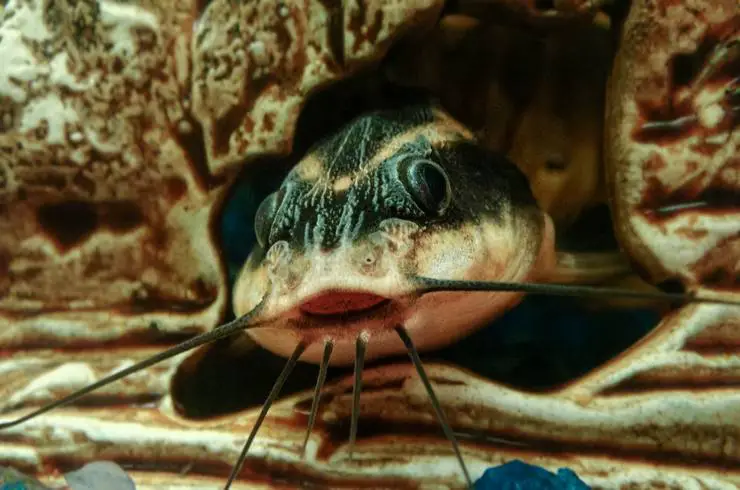
Platydoras are popular aquarium dwellers, and these beautiful striped catfish could have become even more widespread if not for compatibility issues. Unfortunately, when buying these catfish, not every seller warns that the fish has a predatory disposition, it is categorically not recommended to add it to species that can fit in the mouth of the Platidoras. In such a situation, there will be only one outcome – small fish will disappear almost every night, and the owner will not immediately guess that the reason for this is the good appetite of catfish.
Nevertheless, if you keep fish of medium and large size, then Platidoras will become excellent neighbors, but perhaps quite secretive because catfish prefer to hide in shelters during daylight hours and show themselves only at night.
Among the interesting features of Platidoras is their ability to “sing”. Depending on which organs the fish uses to make sounds, they can be chirping or sound like a drumbeat. Basically, you can hear these sounds at night or when frightened. For example, if you pull a fish out of the water, the catfish will certainly give out its alarming trill.
In nature, young Platidoras often help larger species get rid of parasites on the body, which is unusual for freshwater fish.
Given the rather large size of platforms, it is better to settle them in aquariums of 100 liters or more.
Pterygoplicht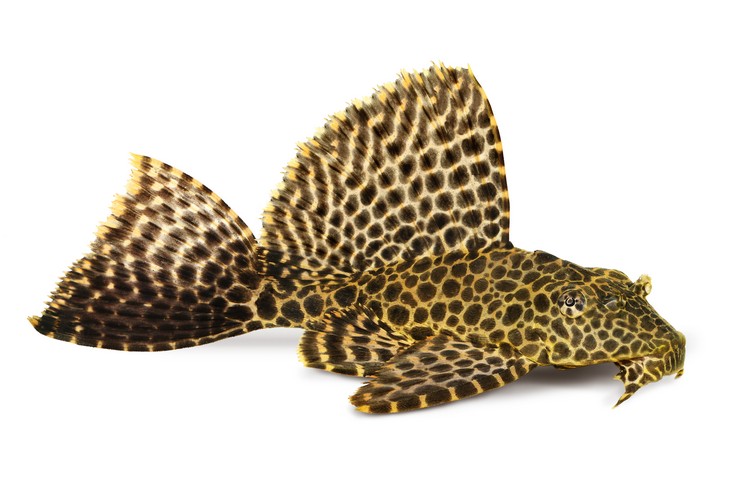
Pterygoplichts are real giants in the world of the aquarium hobby. These chain-mail catfish in a suitable volume can easily grow up to 50 cm. Perhaps, for large aquariums, these fish will become a real decoration, because it is almost impossible to take your eyes off the stunning leopard print and proudly raised fan-shaped dorsal fin.
At first glance, the pterygoplicht may seem like a very formidable catfish, but in fact, it is a rather peaceful species, which (if provided with enough living space) rarely shows aggression towards its neighbors. The basis of the diet of the pterygoplicht, like that of its relatives in the family, is vegetation. This is clearly indicated by the mouth, modified into an addition, which allows scraping algae from glass and decorations. Thus, the pterygoplicht will not only decorate the aquarium but also help keep it clean.
Nevertheless, given the size of this giant, it is certainly not worth settling a catfish with small species of fish, because they can become an accidental victim. It is optimal if one pterygoplicht will have at least 250 liters of water. The fish goes well with large cichlids. It is best to feed them with special pills high in spirulina.
Synodontis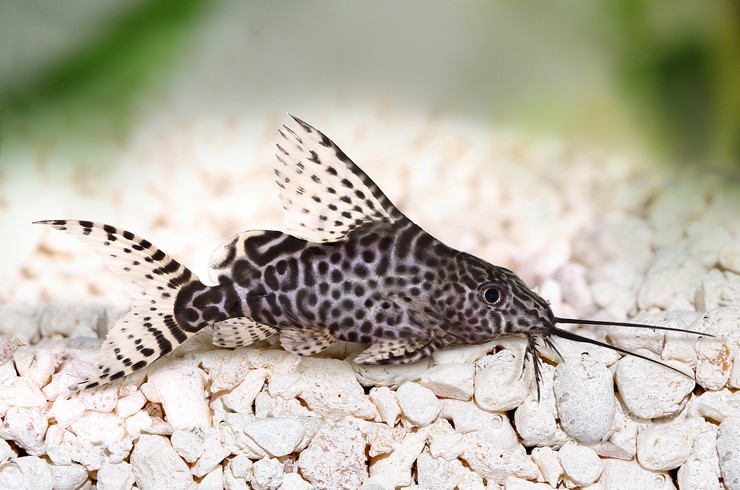
If you are a fan of medium and large cichlids, then be sure to pay attention to the African synodontis catfish. In a suitable amount, these fish will make an excellent company even for rather an aggressive species (although in this case, it is better to raise them together from childhood). Tendonitis is a large representative of catfish, individuals of certain species can reach 20-30 cm in length.
An interesting feature of tendonitis is the ability to swim upside down, for which the fish are often called upside-down catfish. The content will not cause much trouble to the owner. It is necessary to provide a sufficient volume of the aquarium (preferably from 150 liters), good filtration, and aeration. Synodontis are unpretentious in their diet and eat good quality dry catfish food.
It is worth noting that all types of synodontis are very beautiful. Their colors often include spots or stripes. Well-developed dorsal and caudal fins often have a veil.
Speaking about tendonitis, one cannot fail to mention the unusual form of reproduction of certain species of these catfish, which is called “parasitic spawning”. The essence of this phenomenon lies in the fact that the female Synodontis imperceptibly tosses its eggs to the cichlids, which incubate them in their oral cavity. But synodontis develop much faster, their fry immediately destroy their own eggs of cichlids.
When planning to purchase tendonitis for a common aquarium, be sure to keep in mind that the fish quickly grows large and can easily eat small fish species.
Glass catfish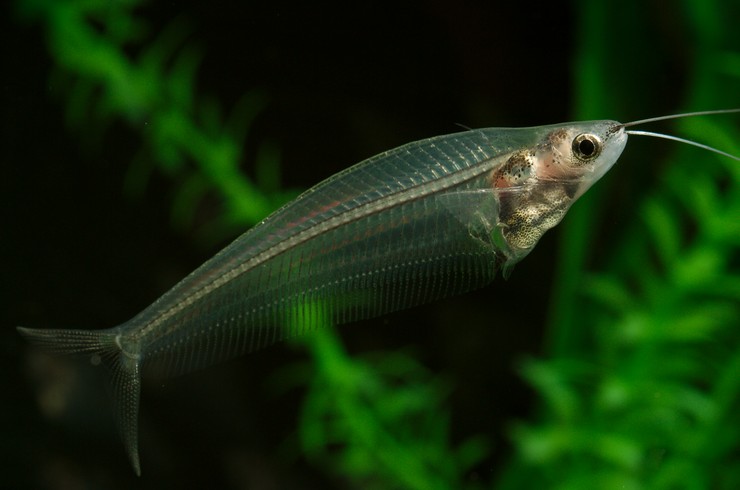
Glass catfish are perhaps one of the most interesting aquarium fish. Their distinctive feature is the absence of pigmentation in the scales, so you can easily see all the insides of this unusual fish. Because the fish sometimes “merge” with the environment, they are often called ghost catfish.
It is recommended to contain glass catfish in large flocks in a volume of 100 liters or more. It is very important that the biological balance is established in the aquarium because the fish are extremely sensitive to the content of nitrogenous compounds in the water. Tropical aquariums with live plants are best.
Glass catfish are peaceful and go well with any non-aggressive fish species. They perfectly eat high-quality dry food in cereals or chips, so you will not have any problems with feeding them either.
Toracatum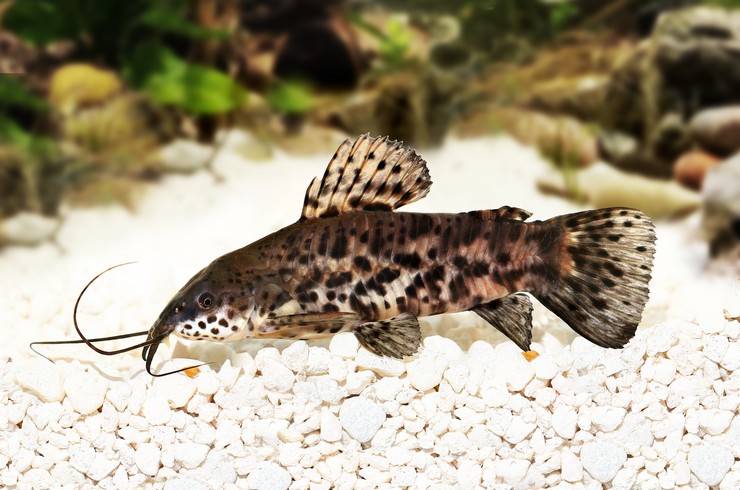
Torakatums are peaceful aquarium catfish that get along well with other fish species and will “revive” the bottom layer of water. Unlike many other catfish, which prefer to constantly hide from prying eyes, most of the thoracotomy is active, constantly crawling among plants and decorations in search of something edible. Catfish are especially mobile during flock keeping.
The size of an adult catfish is about 12 cm. The body is covered with two rows of dense plates that perform a protective function. Near the mouth are two pairs of mustaches. The main body color is brown with small spots.
Toracatums are wonderful helpers for the aquarist because by collecting the remains of food at the bottom, they do not allow them to decompose and spoil the water. Do not forget to provide shelter for the fish, where they can rest if they wish. Yes, and dimming the light with the help of plants floating on the surface will be completely useful.
The reproduction process is interesting for thoracotomy. Males build special nests from bubbles, this behavior is completely unusual for catfish and more like labyrinth fish.
